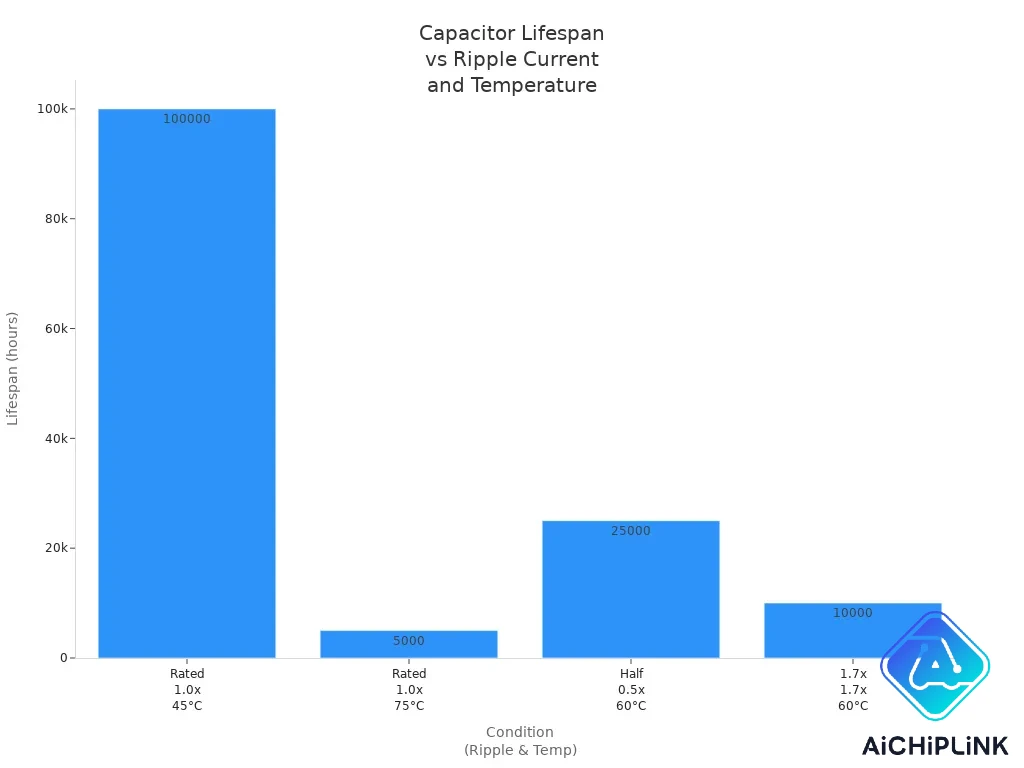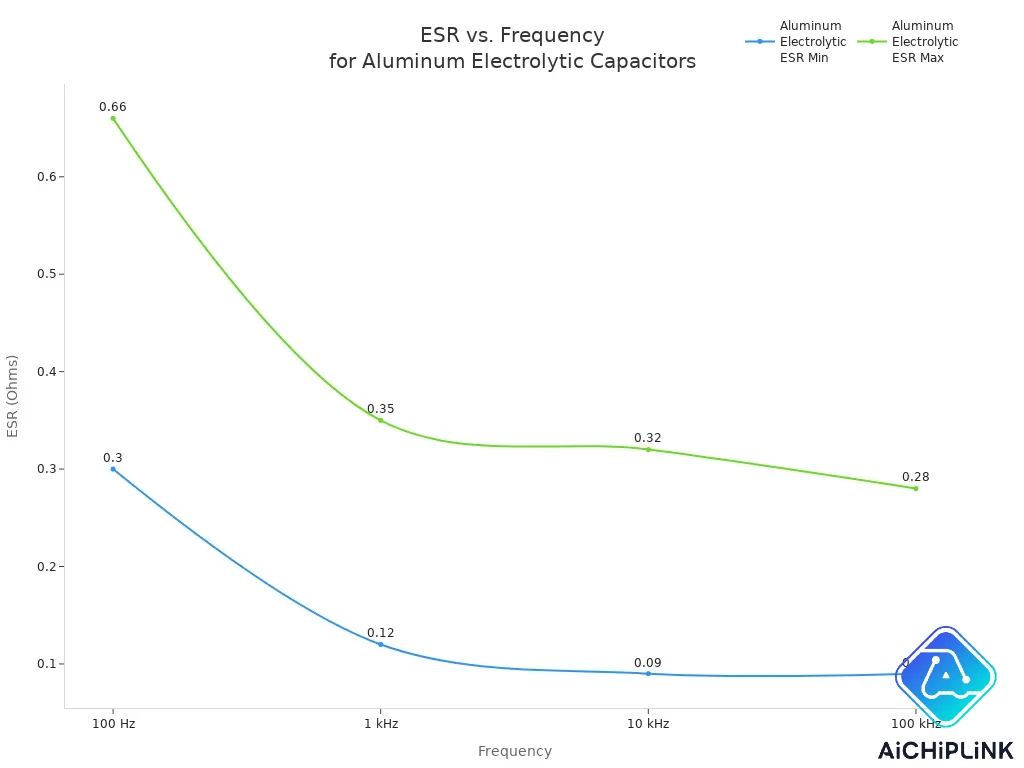
You can think of ESR in capacitors as a secret resistance inside each one. This equivalent series resistance makes extra heat and lowers how well the capacitor works, especially in power filtering and audio circuits.
If you ignore ESR, you might get problems like noise, voltage drops, or even shorter life for parts.
-
High ESR causes more power loss and self-heating, which makes capacitors get old faster.
-
Checking ESR in capacitors often helps your circuits work well and last longer.
Be careful about ESR when you pick capacitors for any project.
Key Takeaways
-
ESR is a hidden resistance inside capacitors. It makes heat and wastes energy. This can hurt how circuits work and how long capacitors last.
-
High ESR makes more heat and noise. It also causes voltage drops. Capacitors do not last as long, especially in power and high-frequency circuits.
-
Different capacitors have different ESR levels. Low ESR capacitors, like ceramic and polymer types, work better and are more reliable.
-
Special meters can measure ESR. These meters help find bad capacitors early. This keeps circuits working well.
-
Pick low ESR capacitors and put them close to circuit parts. This lowers noise, heat, and power loss. It helps devices last longer.
ESR in Capacitors
What Is ESR
People talk about ESR in capacitors a lot in electronics. ESR means equivalent series resistance. This is a small resistance inside the capacitor. It is there along with the part that stores charge. Every real capacitor has this resistance. It sits in series with the main capacitance.
ESR works like a hidden resistor inside your capacitor. It makes energy get lost and heat up when current flows.
ESR changes how well capacitors filter signals. It also affects how they handle power and how long they last. You should pay attention to ESR. It can change how your circuit works. This is very important in high-frequency or high-current circuits.
Sources of ESR
ESR comes from the materials and design of the capacitor. Here are the main sources for different types:
-
Electrolytic capacitors have ESR because of the ionic electrolyte inside. This liquid can dry out as time passes. That makes resistance go up and shortens life. The chemicals inside, like water-based or polymer-based electrolytes, also change ESR. Heat and evaporation make things worse.
-
Polymer electrolytic capacitors use special conductive polymers. These lower ESR and help the capacitor last longer. But some solvent still dries out over time.
-
Film capacitors use plastic film and metal electrodes. Their design keeps ESR very low. The size and how they are built also matter. Metallized film capacitors can heal themselves. This keeps ESR low and makes them more reliable.
-
Ceramic capacitors use ceramic material and metal electrodes. ESR depends on the type of ceramic and how the electrodes are made. Multi-layer ceramic capacitors have very low ESR because of their design and materials.
The physical and chemical nature of each type affects ESR. How the capacitor is built, what materials are used, and even the shape all matter. These things change how much ESR you get.
Ideal vs. Real Capacitor
You might think a capacitor only stores and releases charge. In theory, an ideal capacitor does just that. It has zero ESR and does not lose energy.
Real capacitors always have some ESR. This comes from the dielectric material, the electrodes, and the leads.
When you use a real capacitor, ESR causes power loss and heat. Sometimes it even makes noise. If you run high current through a capacitor with high ESR, it heats up. It may fail sooner. For example, a capacitor with 100 milliohms ESR and 1 amp ripple current will lose 0.1 watts as heat. This heat can hurt the capacitor and nearby parts.
You should pick capacitors with low ESR for circuits that need high efficiency or lots of current. Multi-layer ceramic capacitors are good for these jobs because their ESR is very low. Modern technology helps lower ESR. But you can never get rid of it completely.
The table below shows typical ESR values for different capacitor types. You can use this to compare and pick the right part for your project.
| Capacitor Type | ESR Range (Ω) for 22 µF | ESR Range (Ω) for 100 µF | ESR Range (Ω) for 470 µF |
|---|---|---|---|
| Standard Aluminum | 7–30 | 2–7 | 0.13–1.5 |
| Low-ESR Aluminum | 1–5 | 0.3–1.6 | N/A |
| Solid Aluminum | 0.2–0.5 | N/A | N/A |
| Sanyo OS-CON | 0.04–0.07 | 0.03–0.06 | N/A |
| Standard Solid Tantalum | 1.1–2.5 | 0.9–1.5 | N/A |
| Low-ESR Tantalum | 0.2–1 | 0.08–0.4 | N/A |
| Wet-Foil Tantalum | 2.5–3.5 | 1.8–3.9 | N/A |
| Stacked-Foil Film | < 0.015 | N/A | N/A |
| Ceramic | < 0.015 | N/A | N/A |

You can see that aluminum electrolytic capacitors have much higher ESR than ceramic or film types. When you design a circuit, you should check the ESR in capacitors. This helps your project work well and last longer.
Capacitor ESR Effects
Heat and Power Loss
When you use a capacitor, high ESR acts like a hidden resistor. This resistance changes some electrical energy into heat. More current flowing through the capacitor makes more heat. You can use a simple formula to figure this out:
If a lot of ripple current goes through a capacitor with high ESR, it gets hot inside. This heat makes the core temperature go up. When the temperature rises, the capacitor ages faster and works worse. The capacitor might stop working much sooner than you expect.
-
High equivalent series resistance in capacitors causes heat loss.
-
More ripple current means more heat is made.
-
High temperatures from heat make capacitors wear out faster.
-
Voltage drop across the ESR lowers the energy you get.
You can see how temperature and ripple current change capacitor life in the table below:
| Condition | Ripple Current (relative to rated) | Temperature (°C) | Lifespan (hours) |
|---|---|---|---|
| Rated ripple current | 1.0x | 45 | 100,000 |
| Rated ripple current | 1.0x | 75 | 5,000 |
| Half rated ripple current | 0.5x | 60 | 25,000 |
| 1.7 times rated ripple current | 1.7x | 60 | 10,000 |

If you use a capacitor with high ESR in a power supply, it heats up fast. This heat can hurt the capacitor and other parts nearby. Over time, the capacitor may not store charge well or might short out. Always check the ESR value when you design circuits for high currents.
Efficiency and Reliability
ESR does more than just make heat. High ESR lowers how well your circuit works. More energy gets wasted as heat instead of powering your device. In switching power supplies, high ESR can make the output voltage drop and cause problems. You might see more noise or strange things happen in your circuit.
Repair workers often find broken capacitors with very high ESR. These problems happen most in small capacitors that run at high voltages. Things like moisture, heat, or bad building can make ESR go up. When this happens, your circuit might stop working or become unreliable.
-
Polymer tantalum capacitors can break if moisture or heat raises ESR.
-
Aluminum electrolytic capacitors lose liquid over time, raising ESR and causing leaks.
-
Bad building, like poor connections inside, also raises ESR.
-
High temperature and humidity make ESR worse and lower reliability.
If you want your circuit to last, you must watch out for ESR. High ESR can lower capacitance, cause more leaks, and even make the part fail.
In power supplies, ESR changes output impedance and control loop stability. Sometimes, using a very low ESR capacitor can cause other problems, like peaks at certain frequencies. In audio amplifiers, ESR does not usually hurt sound if you pick the right capacitor and use a good layout. Using one big low ESR capacitor can make your circuit smaller and more reliable.
High-Frequency Impact
High-frequency jobs need capacitors that handle fast voltage and current changes. High ESR in these cases causes big trouble. You will see more noise and voltage ripple in your circuit. For example, if you use a capacitor with 0.44 ohms ESR, you might get a 1-volt ripple. That is too much for most circuits.
-
High ESR in output capacitors causes bigger voltage ripple and noise in switching regulators.
-
You should pick output capacitors with ESR around 20 milliohms or less.
-
Low ESR capacitors, like aluminum polymer or ceramic MLCCs, help lower ripple and noise.
-
High ESR also means more heat and shorter life for the capacitor.
-
The way your circuit board is built matters too. Long leads and bad copper pours add inductance and make noise worse.
Switching transients in high-frequency circuits have lots of high-frequency energy. These depend on both ESR and the inductance of the capacitor and the circuit layout. If you use several low ESR ceramic capacitors together, you can lower both ESR and inductance. This helps the circuit respond faster and cuts down on noise.
The effects of ESR in high-frequency circuits can make your circuit noisy, slow, or unstable. Always pick capacitors with low ESR for these jobs.
ESR and Frequency
Frequency Dependence
ESR does not stay the same at all frequencies. When you use a capacitor, ESR can change as frequency changes. The materials inside the capacitor react differently at different speeds.
-
Aluminum electrolytic capacitors have higher ESR at low frequencies.
-
When frequency goes up, ESR drops until it hits a low point.
-
At very high frequencies, ESR can rise again because of how the capacitor is made.
You can see this pattern in the table below:
| Frequency | ESR Range for Aluminum Electrolytic Capacitors (Ohms) |
|---|---|
| 100 Hz | About 0.3 to 0.66 |
| 1 kHz | About 0.12 to 0.35 |
| 10 kHz | About 0.09 to 0.32 |
| 100 kHz | About 0.09 to 0.28 |
Multilayer ceramic capacitors (MLCCs) have very low ESR at many frequencies. This makes them good for high-frequency circuits. For example, a chip capacitor might have ESR of 0.05 ohms at 200 MHz, 0.11 ohms at 900 MHz, and 0.14 ohms at 2000 MHz.

Tip: Always check how ESR changes with frequency when you design high-frequency circuits. This helps you stop noise and power loss.
Temperature and Aging
Temperature and aging also change ESR in capacitors. When temperature goes up, ESR in aluminum electrolytic capacitors can drop at first. The liquid inside becomes more conductive. But if it stays hot for a long time, the liquid dries out. This makes ESR go up and the capacitor can fail.
Solid tantalum capacitors handle heat better. Their ESR stays more stable at high temperatures, especially with special materials. Some types work even at 230°C. But if the inside layers separate from heat, ESR can still go up.
As capacitors get older, their ESR usually rises. This happens faster at high temperatures. Aluminum capacitors show the biggest ESR increase as they age. Ceramic capacitors keep ESR more stable, but they may not store charge as well. When ESR goes up, your circuit can get more noise and lose efficiency. You might see power problems, especially at low frequencies.
Note: Always plan for ESR changes as time passes. Pick capacitors that fit your circuit’s needs now and later.
Measuring ESR

Measurement Methods
There are a few ways to check ESR in a capacitor. You cannot use a regular ohmmeter because capacitors block DC. You need special tools that use AC signals. ESR meters send a small AC current through the capacitor. They measure the voltage drop and show the ESR value. You can use ESR meters without taking the capacitor out of the circuit. This saves time. But other parts on the board can change the reading. So, the results may not be perfect.
LCR meters give more exact results. These meters measure inductance, capacitance, and resistance, including ESR. You usually need to take the capacitor out of the circuit for best results. LCR meters work at many frequencies and give detailed numbers. They are good for lab work or when you need very precise data.
Here is a simple table to compare the methods:
| Method | Description | Accuracy Consideration |
|---|---|---|
| Multimeter (In-Circuit) | Test the capacitor while it is still on the board. | Easy, but not very accurate. |
| Multimeter (Out-of-Circuit) | Take the capacitor out and test it. | More accurate than testing on the board. |
| ESR Meter | Measures ESR directly, often while the part is in the circuit. | Quick, but other parts can affect results. |
| LCR Meter | Measures ESR and other values, usually with the part removed. | Most accurate, best for careful testing. |
Tip: Use an ESR meter for fast checks. Use an LCR meter for careful and detailed tests.
Identifying High ESR
High ESR in capacitors can make your circuits act up. You might see some clear signs if a capacitor has high ESR:
-
The capacitor feels hot or looks swollen.
-
Power supplies show strange voltages or extra ripple.
-
Audio circuits sound weird or have noise.
-
Devices lose power or turn off by themselves.
-
Timing circuits do not work right because the capacitor is slow.
You can also use an oscilloscope to look for ripple voltage on power lines. If you see more ripple than usual, a bad capacitor could be the reason. Sometimes, you will see leaking or bulging capacitors. This means you should replace them.
Note: Always look for these signs if your circuit is not working well. Changing a capacitor with high ESR can fix many problems.
Choosing Low ESR Capacitors
Application Needs
You must pick a capacitor with the right ESR for your circuit. Switching power supplies need low ESR capacitors. These keep voltage steady and cut down ripple. Audio circuits also need low ESR. This keeps noise low and makes sound better. RF circuits need very low ESR. This stops signal loss and keeps performance high. Decoupling capacitors with low ESR block high-frequency noise. They help keep voltage steady for sensitive chips. Always look at the datasheet for ESR values. Make sure the ESR fits your project.
Tip: Put low ESR capacitors close to ICs. This helps with filtering and keeps things stable.
Here is a table with good ESR values for different jobs:
| Application | Recommended ESR Value | Notes |
|---|---|---|
| Switching Power Supply | ~10 mΩ to 400 mΩ at 1.5 MHz | Lower ESR cuts ripple and helps stability. |
| Audio Circuits | < 1 Ω | Low ESR keeps noise and distortion away. |
| RF Circuits | < 0.01 Ω | Very low ESR is needed for strong signals. |
Low ESR Benefits
Low ESR capacitors help your circuits in many ways:
-
They make less heat and waste less energy. This helps parts last longer.
-
They keep voltage ripple small. Power supplies work better.
-
They boost performance in fast and strong circuits.
-
They stop extra noise and signal problems.
-
They let you use smaller capacitors with high capacitance.
Using low ESR capacitors means your devices stay cool, work well, and last longer.
Selection Tips
When picking capacitors, look for low ESR in the datasheet. Some brands show ESR or give dissipation factor. You can use this to guess ESR. Online tools from Murata or Kemet help you compare ESR and other features. Ceramic capacitors with X7R or X5R dielectric are good for low ESR. Make sure the voltage rating is at least double your circuit’s voltage. Check ESR at the frequency and temperature your device will run. For top circuits, always choose the lowest ESR that works for you.
-
Check ESR at the frequency and temperature you use.
-
Use brand tools to get the right ESR data.
-
Pick capacitors with X7R or X5R dielectric for low ESR.
-
Make sure the voltage rating is high enough to be safe.
-
Compare datasheets from different brands to find the best one.
Note: Low ESR capacitors help your electronics stay stable, work well, and last a long time.
You should know about ESR in capacitors to make good circuits. ESR adds extra resistance. This makes heat and wastes energy. High ESR can cause ripple voltage and bad filtering. It can also make power supplies unstable. You can make your designs better by picking low-ESR capacitors. Test them often to keep things working well.
-
High ESR makes circuits work worse.
-
Using low-ESR parts and smart layout keeps circuits strong.
| Aspect | Actionable Steps |
|---|---|
| Design | Pick low-ESR capacitors and use several together. |
| Layout | Put capacitors close to IC pins with short paths. |
| Procurement | Test and choose capacitors with low ESR. |
You can learn more by reading datasheets. You can also look at guides online to help pick capacitors.
FAQ
What does ESR stand for in capacitors?
ESR means Equivalent Series Resistance. You can think of it as a small, hidden resistor inside every real capacitor. This resistance affects how well your capacitor works in a circuit.
Why should you care about ESR when choosing capacitors?
High ESR can cause heat, noise, and power loss. Your circuit may not work well or could fail early. Always check ESR values in datasheets before you pick a capacitor for your project.
How do you measure ESR in a capacitor?
You can use an ESR meter or an LCR meter. These tools send a small AC signal through the capacitor and show the ESR value. You do not need to remove the capacitor from the circuit for a quick check.
What are signs of high ESR in a circuit?
You might notice:
Extra noise or ripple in power supplies
Hot or bulging capacitors
Devices shutting off or acting strange
These signs mean you should check and possibly replace the capacitor.

Written by Jack Elliott from AIChipLink.
AIChipLink, one of the fastest-growing global independent electronic components distributors in the world, offers millions of products from thousands of manufacturers, and many of our in-stock parts is available to ship same day.
We mainly source and distribute integrated circuit (IC) products of brands such as Broadcom, Microchip, Texas Instruments, Infineon, NXP, Analog Devices, Qualcomm, Intel, etc., which are widely used in communication & network, telecom, industrial control, new energy and automotive electronics.
Empowered by AI, Linked to the Future. Get started on AIChipLink.com and submit your RFQ online today!













